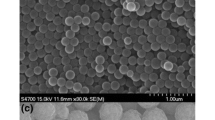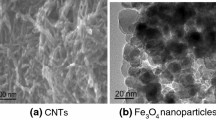Abstract
Single-alkyl chain-containing amphiphilic oligomers with a terminal alkyl chain and several sugar side chains (i.e., C n -mGEMA, where n represents alkyl chain lengths of 12 or 16 and m represents the polymerization degree of glycosyloxyethyl methacrylate (GEMA) units of 3.0–7.1), and multi-alkyl chain-containing amphiphilic oligomers with several sugar side chains (i.e., xC12-mGEMA, where x represents the average number of alkyl chains and x–m is 0.2–6.6, 1.8–4.7, and 3.4–3.7), were synthesized via the radical oligomerization of one or two monomers in the presence of alkanethiol or 2-aminoethanethiol hydrochloride. Surface tension, pyrene fluorescence, and small-angle neutron scattering (SANS) measurements were used to characterize the solution properties of the oligomers and the nanostructures of their aggregates. Both amphiphilic oligomers are highly efficient in reducing the surface tension of water (42–48 mN m−1 for C n -mGEMA and 36–46 mN m−1 for xC12-mGEMA), despite the relatively large structures of the hydrophilic parts in sugar GEMA units. The critical micelle concentration (CMC) of C n -mGEMA and xC12-mGEMA increased with an increase in the degree of polymerization for hydrophilic GEMA units and a decrease in the alkyl chain length. The results of SANS determined that C n -mGEMA formed prolate ellipsoid micelles with a radius of 1.96 nm and an axial ratio of 1.58 for a low degree of polymerization (m = 3.0) in solution. However, the radius decreased to 1.33 nm and the axial ratio increased to 5.04 as the degree of polymerization of the amphiphilic oligomers increased to m = 7.1, indicating structural transformation to an asymmetric ellipsoid. On the other hand, the structure of the aggregates formed by xC12-mGEMA changed from ellipsoidal to an ellipsoidal cylinder shape with increasing number of alkyl chains, i.e., decreasing the number of GEMA units.





Similar content being viewed by others
References
Ruiz CC (2008) Sugar-based surfactants: fundamentals and applications. Marcel Dekker, Inc., New York
Burczyk B (2003) In: Holmberg K (ed) Novel surfactants; preparation, applications, and biodegradability. Chapter 4, 2nd edn. Marcel Dekker, Inc., New York
Davey TW (2004) In: Zana R, Xia J (eds) Gemini surfactants: synthesis, interfacial and solution-phase behavior, and applications. Chapter 11. Marcel Dekker, Inc., New York
Johnsson M, Wagenaar A, Stuart MCA, Engberts JBFN (2003) Sugar-based gemini surfactants with pH-dependent aggregation behavior: vesicle-to-micelle transition, critical micelle concentration, and vesicle surface charge reversal. Langmuir 19:4609–4618
Syper L, Wilk KA, Sokolowski A, Burczyk B (1998) Synthesis and surface properties of N-alkylaldonamides. Prog Colloid Polym Sci 110:199–203
Wilk KA, Syper L, Domagalska BW, Komorek U, Maliszewska I, Gancarz R (2002) Aldonamide-type gemini surfactants: synthesis, structural analysis, and biological properties. J Surfact Deterg 5:235–244
Komorek U, Wilk KA (2004) Surface and micellar properties of new nonionic gemini aldonamide-type surfactants. Colloid Interface Sci 271:206–211
Gao C, Millqvist-Fureby A, Whitcombe MJ, Vulfson EN (1999) Regioselective synthesis of dimeric (gemini) and trimeric sugar-based surfactants. J Surfact Deterg 2:293–302
Ferrer M, Cruces MA, Plou FJ, Bernabe M, Ballesteros A (2000) A simple procedure for the regioselective synthesis of fatty acid esters of maltose, leucrose, maltotriose and n-dodecyl maltosides. Tetrahedron 56:4053–4061
Ferrer M, Comelles F, Plou FJ, Cruces MA, Fuentes G, Parra JL, Ballesteros A (2002) Comparative surface activities of di- and trisaccharide fatty acid esters. Langmuir 18:667–673
Gregg RA, Alderman DM, Mayo FR (1948) Chain transfer in the polymerization of styrene. V. Polymerization of styrene in the presence of mercaptans. J Am Chem Soc 70:3740–3743
Hanford WE, Sargent DE, Gilman H (1953) Organic chemistry, vol. 4. Wiley, New York
Yamada K, Morita H (1973) Studies on the special type surfactants. I. Preparation and properties of derivatives telomers of n-dodecyl alcohol and poly(methyl acrylate). J Jpn Oil Chem Soc 22:790–795
Yamada K, Koide Y (1981) Telomer type surfactants. J Jpn Oil Chem Soc 30:2–9
Koide Y, Eda Y, Yamada K (1986) Studies on special type surfactants. XVI. Preparation of telomer-type surfactants containing 4-vinylpyridine and oxidative polymerization of 2,6-xylenol using their copper complexes. Bull Chem Soc Jpn 59:2963–2968
Esumi K, Mizutani H, Shoji K, Miyazaki M, Torigoe K, Yoshimura T, Koide Y, Shosenji H (1999) Physicochemical properties of 2-vinylpyridine telomers possessing multihydrocarbon chains in aqueous solution and at the silica/aqueous solution interface. J Colloid Interface Sci 220:170–173
Yoshimura T, Koide Y, Shosenji H, Esumi K (2002a) Preparation and surface-active properties of telomer-type anionic surfactants from maleic anhydride. J Surfact Deterg 5:257–262
Yoshimura T, Kiridoshi Y, Koide Y, Shosenji H, Esumi K (2002b) Synthesis and properties of N-(α-carboxyalkyl)acrylamide telomer-type surfactants having multihydrocarbon chains. J Surfact Deterg 5:159–164
Rosen MJ, Kunjappu JT (2012) Surfactants and interfacial phenomena, 4th edn. Wiley, Hoboken
Takata S, Suzuki J, Shinohara T, Oku T, Tominaga T, Ohishi K, Iwase H, Nakatani T, Inamura Y, Ito T, Suzuya K, Aizawa K, Arai M, Otomo T, Sugiyama M (2015) The design and q resolution of the small and wide angle neutron scattering instrument (TAIKAN) in J-PARC. JPS Conf Proc 8:036020-1–6
Percus JK, Yevick G (1958) Analysis of classical statistical mechanics by means of collective coordinates. Phys Rev 110:1–13
Hayter JB, Penfold J (1981) An analytic structure factor for macroion solutions. Mol Phys 42:109–118
Kotlarchyk M, Chen SH (1983) Analysis of small angle neutron scattering spectra from polydisperse interacting colloids. J Chem Phys 79:2461–2469
Rosen MJ, Cohen AW, Dahanayake M, Hua X-Y (1982) Relationship of structure to properties in surfactants. 10. Surface and thermodynamic properties of 2-dodecyloxypoly(ethenoxyethanol)s, C12H25(OC2H4)xOH, in aqueous solution. J Phys Chem 86:541–545
Yoshimura T, Ishihara K, Esumi K (2005) Sugar-based gemini surfactants with peptide bonds – synthesis, adsorption, micellization, and biodegradability. Langmuir 21:10409–10415
Yoshimura T, Umezawa S, Fujino A, Torigoe K, Sakai K, Sakai H, Abe M, Esumi K (2013) Equilibrium surface tension, dynamic surface tension, and micellization properties of lactobionamide-type sugar-based gemini surfactants. J Oleo Sci 62:353–362
Sakai K, Umezawa S, Tamura M, Takamatsu Y, Tsuchiya K, Torigoe K, Ohkubo T, Yoshimura T, Esumi K, Sakai H, Abe M (2008) Adsorption and micellization behavior of novel gluconamide-type gemini surfactants. J Colloid Interface Sci 318:440–448
Kratky O, Pilz I (1972) Recent advances and applications of diffuse X-ray small-angle scattering on biopolymers in dilute solutions. Q Rev Biophys 5:481–537
Kusano T, Iwase H, Yoshimura T, Shibayama M (2012) Structural and rheological studies on growth of salt-free wormlike micelles formed by star-type trimeric surfactants. Langmuir 28:16798–16806
Acknowledgments
We are grateful to Nippon Fine Chemical Co. Ltd. (Osaka, Japan) for the supply of glucosyloxyethyl methacrylate (GEMA). The SANS experiment was performed with the approval of the Neutron Program Review Committee (proposal no. 2012A0082).
Author information
Authors and Affiliations
Corresponding author
Ethics declarations
Not applicable.
Funding
This study was funded by Nara Women’s University Intramural Grant for Project Research.
Conflict of interest
The authors declare that they have no conflict of interest.
Electronic supplementary material
ESM 1
(DOC 233 kb).
1H NMR data of the single-chain amphiphilic oligomers C n -mGEMA and multi-chain amphiphilic oligomers xC12-mGEMA, and details of experimental methods.
Rights and permissions
About this article
Cite this article
Yoshimura, T., Nakatani, Y., Matsuoka, K. et al. Single-alkyl and multi-alkyl chain-containing amphiphilic oligomers with several sugar side chains: solution properties and nanostructural analysis of aggregates by SANS. Colloid Polym Sci 295, 793–802 (2017). https://doi.org/10.1007/s00396-017-4063-3
Received:
Revised:
Accepted:
Published:
Issue Date:
DOI: https://doi.org/10.1007/s00396-017-4063-3




